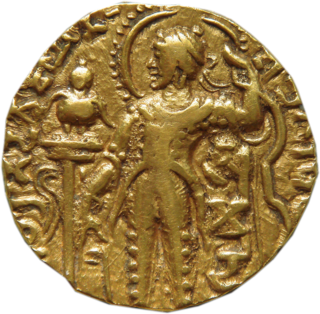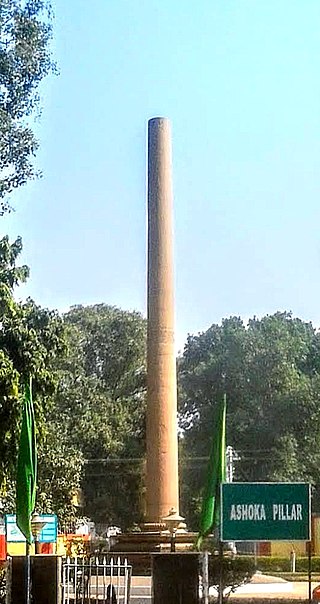Related Research Articles
The Gupta Empire was an Indian empire during the classical period of the Indian subcontinent which existed from the mid 3rd century to mid 6th century CE. At its zenith, the dynasty ruled over an empire that spanned much of the northern Indian subcontinent. This period has been considered as the Golden Age of India by some historians, although this characterisation has been disputed by others. The ruling dynasty of the empire was founded by Gupta.

Chandragupta II, also known by his title Vikramaditya, as well as Chandragupta Vikramaditya, was the Gupta emperor. Modern scholars generally identify him with King Chandra of the Delhi iron pillar inscription.

Chandragupta I was a monarch of the Gupta Empire, who ruled in northern and central India. His title Mahārājadhirāja suggests that he was the first suzerain ruler of the dynasty. It is not certain how he turned his small ancestral kingdom into an empire, although a widely accepted theory among modern historians is that his marriage to the Licchavi princess Kumaradevi helped him extend his political power. Their son Samudragupta further expanded the Gupta Empire.

Samudragupta (Gupta script: Sa-mu-dra-gu-pta, was the second emperor of the Gupta Empire of ancient India, and is regarded among the greatest rulers of India. As a son of the Gupta emperor Chandragupta I and the Licchavi princess Kumaradevi, he greatly expanded his dynasty's political and military power.

Kumaragupta I was Gupta emperor from 415 until his death in 455. A son of the Gupta king Chandragupta II and Queen Dhruvadevi, he seems to have maintained control of his inherited territory, which extended from Gujarat in the west to Bengal region in the east.

Gupta was the founder of the Gupta dynasty of northern India. He is identified with king Che-li-ki-to, who, according to the 7th-century Chinese Buddhist monk Yijing, built a temple near Mi-li-kia-si-kia-po-no (Mṛgaśikhāvana) for Chinese pilgrims. This temple was located somewhere in eastern India: based on the identification of its location, modern scholars variously locate Gupta's territory in present-day eastern Uttar Pradesh or Bengal region.

The Licchavis of Nepal ruled over a kingdom in the Kathmandu Valley of Nepal from approximately 450 to 750 CE. The Licchavi clan originated from a branch of the Licchavis of Vaishali who ruled in the territory of modern-day Bihar and who later conquered the Kathmandu Valley. The Licchavis were ruled by a maharaja, aided by a prime minister and other royal officials, but in practice local communities were controlled by caste councils.

Ramagupta, according to the Sanskrit play Devichandraguptam, was an emperor of the Gupta dynasty of northern India. The surviving fragments of the play, combined with other literary evidence, suggest that he agreed to surrender his wife Dhruvadevi to a Shaka enemy: However, his brother Chandragupta II killed the Shaka enemy, and later dethroned him, marrying Dhruvadevi.
The Western Satraps, or Western Kshatrapas were Indo-Scythian (Saka) rulers of the western and central parts of India, between 35 and 415 CE. The Western Satraps were contemporaneous with the Kushans who ruled the northern part of the Indian subcontinent, and were possibly vassals of the Kushans. They were also contemporaneous with the Satavahana who ruled in Central India. They are called "Western Satraps" in modern historiography in order to differentiate them from the "Northern Satraps", who ruled in Punjab and Mathura until the 2nd century CE.
Samanta was a title and position used in the history of the Indian subcontinent between 4th and 12th century to denote a vassal, feudal lord or tributary chief. The leader of 100 village also popularly known as jagirdar. The term roughly translates to neighbor. The institution is considered to be closely associated with the origin and growth of feudalism in India and Medieval India.

Ghatotkacha was a pre-imperial Gupta king of northern India. He was a son of the dynasty's founder Gupta, and the father of the dynasty's first emperor Chandragupta I.
The Malavas or Malwas were an ancient Indian tribe. They are believed to be the Mallian people (Malloi) who lived in the Punjab region at the time of Alexander's invasion in the 4th century BCE. Later, the Malavas migrated southwards to present-day Rajasthan, and ultimately to Madhya Pradesh and Gujarat. Their power gradually declined as a result of defeats against the Western Satraps, the Gupta emperor Samudragupta, and the Chalukya emperor Pulakeshin II.

The Allahabad Pillar is a stambha, containing one of the pillar edicts of Ashoka, erected by Ashoka, emperor of the Maurya dynasty, who reigned in the 3rd century BCE. While it is one of the few extant pillars that carry Ashokan edicts, it is particularly notable for containing later inscriptions attributed to the Gupta emperor Samudragupta. Also engraved on the stone are inscriptions by the Mughal emperor Jahangir, from the 17th century.

The Naga dynasty ruled parts of north-central India during the 3rd and the 4th centuries, after the decline of the Kushan Empire and before the rise of the Gupta Empire. Its capital was located at Padmavati, which is identified with modern Pawaya in Madhya Pradesh. Modern historians identify it with the family that is called Bharashiva in the records of the Vakataka dynasty.

The Kalachuris of Mahismati, or the Early Kalachuris, were an early medieval Indian dynasty that ruled present-day Maharashtra, as well as parts of mainland Gujarat and southern Madhya Pradesh. Their capital was located at Mahishmati. Epigraphic and numismatic evidence suggests that the earliest of the Ellora and Elephanta cave monuments were built during the Kalachuri rule.
The Parivrajaka dynasty ruled parts of central India during 5th and 6th centuries. The kings of this dynasty bore the title Maharaja, and probably ruled as feudatories of the Gupta Empire. The dynasty is known from inscriptions of two of its kings: Hastin and Samkshobha.

Kacha was a king of India, possibly a member of the Gupta dynasty. He is known only from his gold coins, which are similar to those of the Gupta king Samudragupta.
Govindagupta was a Gupta prince of ancient India. He was a son of Chandragupta II and Dhruvadevi, and a brother of Kumaragupta.
Śanakanika Maharaja was a feudatory of Chandragupta II or Vikramaditya of the Gupta Dynasty. Śanakanika Maharaja is known from his record on his gift on a Vaishnavism cave temple at Udayagiri, which is dated 82.
The Abhira dynasty was a dynasty that ruled over the western Deccan, where it perhaps succeeded the Satavahana dynasty. From 203 to roughly 270 or 370, this dynasty formed a vast kingdom. The Abhiras had an extensive empire comprising modern-day Maharashtra, Konkan, Gujarat and parts of southern Madhya Pradesh. Some scholars regard the Abhiras as a great almost an imperial power in the third century A.D.
References
- 1 2 3 4 5 Rapson, Edward James (2015). Catalogue of the Coins of the Andhra Dynasty - Scholar's Choice Edition (illustrated ed.). Creative Media Partners, LLC. p. 520. ISBN 978-1298395245 . Retrieved 26 December 2020.
- ↑ Radhakumud Mookerji (1997). The Gupta Empire (Paperback). Motilal Banarsidass. p. 38. ISBN 9788120804401.
- ↑ Kulke & Rothermund 2010.
- 1 2 Bhandarkar, D. R.; Chhabra, B. C. (1981). Gai, G. S. (ed.). Corpus Inscriptionum Indicarum: Inscriptions of the early Gupta Kings. Archaeological Survey of India.
- 1 2 Ganguly, Dilip Kumar (1987). The Imperial Guptas and Their Times. Abhinav Publications. pp. 63–64. ISBN 8170172225.
- ↑ R. C. Majumdar (1981). A Comprehensive History of India. Vol. 3, Part I: A.D. 300-985. Indian History Congress / People's Publishing House. p. 52-54. OCLC 34008529.